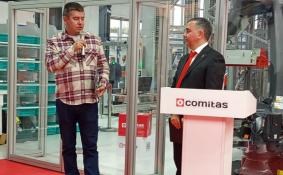
научно-практический
журнал

Новости редакции
Дорогие читатели! Рады представить вам одиннадцатый выпуск журнала в 2025 г. В номере много актуальных и полезных материалов, которые, надеемся, не останутся без внимания.
Научно-практический журнал «ЛОГИСТИКА» официально включен в «Белый список» Российского центра научной информации (РЦНИ). Это значит, что экспертное сообщество подтвердило качество научных публикаций и актуальность исследуемых нашим изданием вопросов.
Президиум Высшей аттестационной комиссии (ВАК) при Министерстве науки и высшего образования Российской Федерации выпустил рекомендацию, согласно которой председателям диссертационных советов при приеме диссертаций к защите нужно проверять количество работ, опубликованных соискателями ученой степени – выпускниками аспирантуры. Рекомендация обусловлена требованиями Постановления Правительства РФ № 842 от 24.09.2013.
Статья недели:

ФОТО НЕДЕЛИ
ЦИТАТЫ
События в российской логистике
GEFCO Launches First Carbon-Neutral Block Train on the New Silk Road
On November 15, 2021, a 41-wagon block train will depart on a three-week journey from Dunajska Strada Slovakia to Xi’an China on the New Silk Road. This block train is GEFCO’s first carbon-neutral train operated for a customer seeking low-carbon transportation solutions for consumer goods. GEFCO will offset the 250 tons of CO2 generated from this door-to-door service by investing in Gold Standard certified projects. In addition, the train will be equipped Internet of Things (IoT) devices to guarantee track and trace, temperature control and product integrity during transit.
Alice Defranoux, Rail Manager at GEFCO, commented: “We are pleased to partner with our longstanding customer to provide this milestone carbon-neutral train. Market demand is increasing for more climate-friendly solutions, especially in long-distance transportation. At GEFCO, we calculate the environmental impact of our solutions, re-engineer them to minimize emissions and propose offsetting solutions for any remaining carbon. Rail is a very good way to achieve reduced carbon emissions.”
The three-week journey on the New Silk Road includes travel from Slovakia to Brest- Małaszewicze at the Polish-Belorussian border, where the goods will be transferred from European to Russian rail wagons to adapt to the 1.52m rail gauge. The block train will then travel through Belarus and Russia and arrive at Alashankou-Dostyk in Kazakhstan, a major link in the Eurasian Land Bridge on the border with Xinjiang, the port of entry into China. The goods will then be loaded on Chinese wagons before their final delivery in Xi’an.












